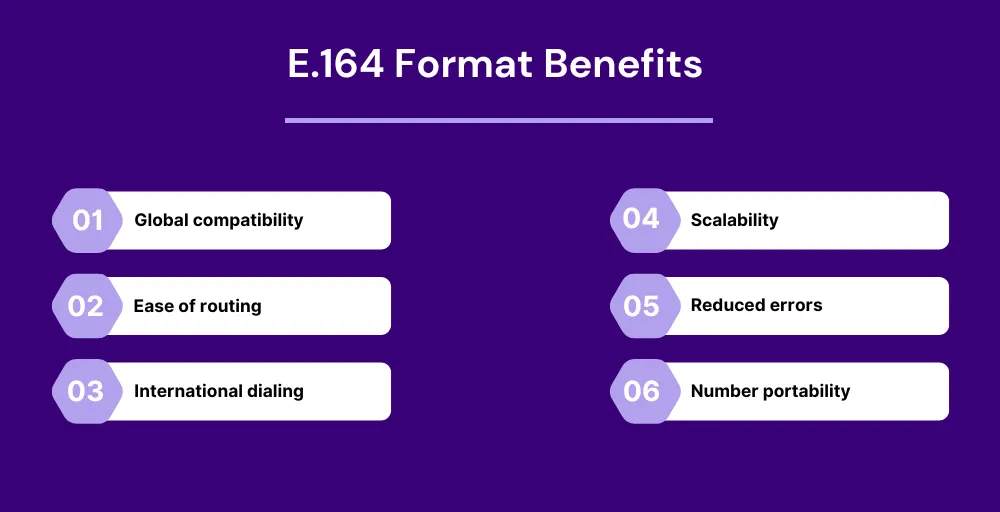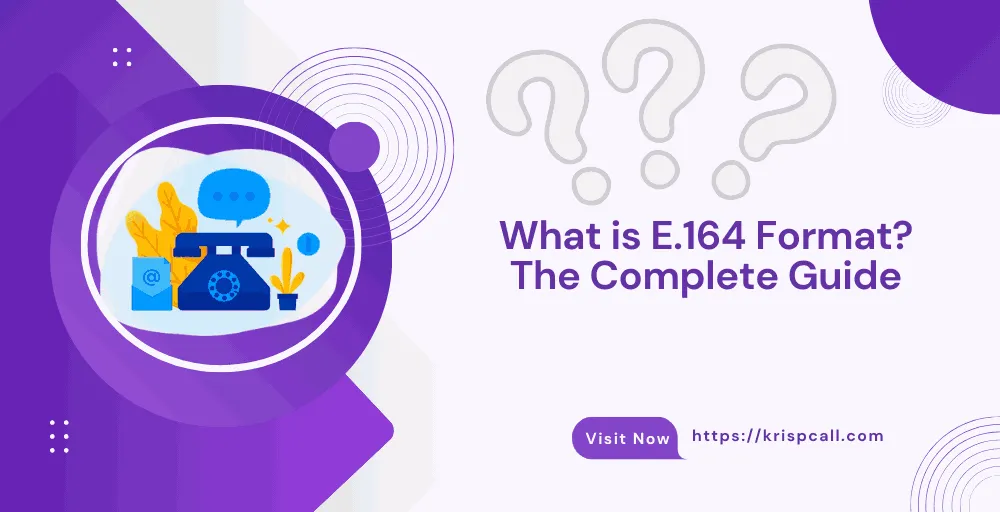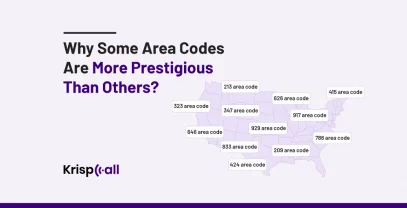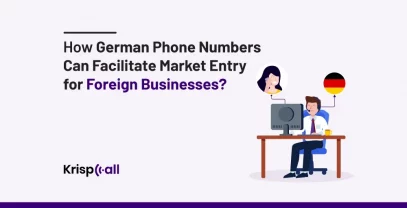Have you ever wondered how phone numbers are standardized globally and what role the E.164 Format plays in this process?🤔
Whether it’s a business reaching out to clients overseas or an individual connecting with loved ones in different countries, standardized phone numbers play a vital role in making these interactions seamless.
The E.164 Format is a standardized global method to represent telephone numbers. It plays a crucial role in making seamless communication across borders and platforms for businesses and individuals.🌟
In this blog, you will learn about the E.164 format, including examples, essential elements, benefits, validating a phone number, and much more.
🗝️Key Highlights
- E.164 is the worldwide telephone numbering plan that assures that each device on the PSTN has a unique number.
- The main components of the E.164 format include the country code, area code, subscriber number, international prefix, and trunk prefix.
- E.164 numbers are written with a plus sign (+), followed by the country code and the subscriber number, which includes the area code if applicable.
- E.164 Format ensures global phone number recognition, simplified routing, straightforward international dialing, and scalability for businesses and individuals.
Let’s get started.🚀
What is the E.164 format?
The E.164 Format is an internationally recognized standard for representing telephone numbers. It provides a structured way to format phone numbers. It is maintained by the International Telecommunication Union (ITU), a specialized agency of the United Nations responsible for information and communication technologies.
The E.164 number is an international phone number format that ensures each number is unique worldwide. It helps to create consistency across various telecommunication systems, devices, and countries.
This format ensures that every PSTN (Public Switched Telephone Network) device possesses a unique and distinct number globally. A globally distinctive telephone number makes accurate routing of calls and SMS to various individual phones worldwide.
What are the key elements of the E.164 format?
The essential elements of the E.164 format are:
- Country code (CC): Each country is assigned a unique code. It is represented by a plus sign (+) followed by one to three digits. For example, the country code for the United States is +1, while the country code for the United Kingdom is +44.
- Area code: Also known as the national destination code (NDC). The local area code identifies a specific geographic region within a country. It is followed by the local subscriber number and is essential for routing calls within a country.
- Subscriber number (SN): The subscriber number is the unique identifier for an individual or business within a specific area code. It varies in length depending on the country’s numbering plan.
- International prefix (IDD): An international prefix must dial an international number from within a country. This prefix signals that the following digits represent an international destination.
- Trunk prefix (or National direct dialing prefix): In some countries, a trunk prefix is used to access long-distance or international numbers when dialing from within the country. It is followed by the country code.
What are the examples of E.164 numbers?
E.164 numbers are formatted with a [+] sign, followed by the country code and subscriber number, including the area code. They can have a maximum of fifteen digits.
Examples of E.164 numbers:
| Country | Country code | Area code | Subscriber Number | E.164 formatted number |
| United States | +1 | 125 | 554 3556 | +11255543556 |
| United Kingdom | +44 | 20 | 3547 8758 | +442035478758 |
| Australia | +61 | 7 | 9876 5432 | +61798765432 |
What are the benefits of using the E.164 Format for global communications?
The benefits of using the E.164 format for global communications are:

- Global compatibility: E.164 ensures that phone numbers are universally recognized and can be dialed correctly from any country or network. This global compatibility is crucial for businesses and individuals communicating across borders.
- Ease of routing: Phone systems use the E.164 format to route calls efficiently across different networks and service providers. This standardized format simplifies routing, reducing errors and ensuring reliable connections.
- International dialing: With E.164, international dialing becomes straightforward. Callers simply need to enter the country code, followed by the phone number in E.164 format, to reach destinations worldwide without confusion or ambiguity.
- Scalability: The E.164 format accommodates the growing demand for phone numbers and ensures scalability for telecommunications networks. It provides a structured framework for assigning and managing phone numbers efficiently.
- Reduced errors: By standardizing phone number formats globally, E.164 reduces errors such as incorrect dialing codes or missing digits. This accuracy improves the reliability of communication services for businesses and consumers.
- Number portability: E.164 supports number portability. It allow users to retain their phone numbers when switching carriers or moving between regions. This feature is vital for maintaining continuity in communication services.
How do you validate a phone number?
You can validate a phone number by checking whether the number follows a specific format or not. Here are the steps to validate a phone number:
- Check format: Verify that the phone number is in the correct format for its country or region. This includes the country code, area code (if applicable), and the local number.
- Verify length: You need to make sure that the number has the correct number of digits according to the standard format for that country or region.
- Check country code: Validate that the country code matches a valid country code from the International Telecommunication Union (ITU) E.164 standard.
- Verify area code: If the number includes an area code, confirm that it corresponds to a valid area code for the country or region.
- Test connectivity: You can optionally test the phone number’s connectivity by attempting to call or send a message.
Wrapping up
The E.164 Format is a vital standard for global phone numbers. It helps to create uniqueness and simplifies cross-border communications. It includes country codes, area codes, and subscriber numbers and enables efficient routing and easy international dialing.💫
KrispCall adopts the E.164 Format, a worldwide standard for phone numbers, to enable businesses to connect with customers globally seamlessly. This format helps accurately route calls and simplifies dialing for international numbers. It makes communication smoother across KrispCall’s network. 😊
FAQs
What is E.164?
E.164 is an international standard that defines the format for telephone numbers. It provides a globally recognized structure for representing telephone numbers and creates consistency across different telecommunication networks and systems worldwide.
What are the components of an E.164-formatted phone number?
An E.164-formatted phone number includes a country code, area code, subscriber number, and optional extension if needed.
Can I dial an E.164-formatted phone number from any country?
Yes, you can dial an E.164-formatted phone number from any country using the appropriate international dialing prefix and the complete E.164 format, including the country code and subscriber number.
Can I port an E.164-formatted phone number between different service providers?
Yes, E.164-formatted phone numbers can be ported between different service providers as long as both providers support number portability.
How do I verify if a phone number is in E.164 format?
To verify if a phone number is in E.164 format, check if it starts with a plus sign (+) followed by the country code and the rest of the digits without any spaces or special characters.





